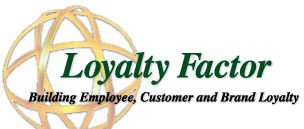Companies Don’t Solve Problems.
People Do.
Building Employee, Customer & Brand Loyalty
In volatile economic times, loyal customers provide a solid foundation of revenues. They can be counted on to purchase new offerings and forward recommendations to potential customers. By simply increasing customer retention from 10% to 15%, companies can double their profits. This presentation explores the relationship between employee, customer and brand loyalty, including real life examples from other companies on improving loyalty. It also provides:
- Techniques for creating employee, customer and brand loyalty.
- Communication strategies for monitoring the employee pulse.
How to Build a Culture Based upon the Globalization of the Workforce
Estimates indicate that within five years, 50 percent of the workforce will be comprised of various cultures, including Spanish, Asian, Cambodian and other minorities. Business leaders must embrace this “melting pot” of cultures in their organizations. In this session, Dianne Durkin will discuss various international cultures and how they can positively impact your organization.
By embracing these differences, organizations will receive valuable new perspectives, expand their approaches, attract new audiences and satisfy the needs of the organization. Attendees will learn how to:
- Prepare for and embrace new cultures.
- Integrate and accept cultural values and differences to ensure maximum productivity.
- Build momentum and excitement for change and learning.
- Outline and address barriers to integrating a global culture.
Employee Engagement vs. Employee Satisfaction
Highly satisfied and engaged employees are as rare as they are valuable. There are significant differences between highly engaged employees and satisfied employees, and satisfaction does not necessarily imply engagement. Engaged employees take ownership, find solutions, are self-starters and find efficient ways to accomplish tasks. Satisfied employees are just happy to go to work each day and do not necessarily take a proactive approach to being a part of an organization. Organizations of today need and want engaged employees who take satisfaction in being part of the solution. In this session attendees will:
- Understand and clearly identify the differences between engaged and satisfied employees.
- Understand “Durkin’s Hierarchy of Engagement Needs” and how to implement the elements of the Engagement Hierarchy.
Managing Today's Multigenerational Workforce
Never before in the business world has there been such a diversity of generations in the workforce: the Veterans (1922-1944), Boomers (1945 – 1960), Xers (1961 – 1980), Gen Y (1980 – 2000), and Gen Z (2000 to present). Each of these generations has different values, needs and motivating factors, which can sometimes make it challenging for managers to understand where their employees are coming from. In this module we discuss the various generations that presently coexist in the workplace. We review their typical traits and explore what each of these generations is looking for from an organization. In this module, managers will learn strategies for motivating, coaching and developing employees from different generations, and how these new generations manage and lead - allowing them to create an environment that is conducive to attracting and retaining talent from a cross-section of individuals.
Building a Culture of Reliability, Responsibility & Accountability
Every organization needs and wants self-directed people who take ownership, develop creative, innovative solutions to business issues and are committed to the success of the organization. In this session, we will discuss the approach leaders should take to succeed in building this type of culture. Attendees will learn:
- The elements of trust and how to build trust with each employee.
- The difference between authoritative-driven cultures vs. responsibility-based cultures.
- How to engage team members in solving problems and owning outcomes.
- How other organizations have built cultures of reliability, responsibility and accountability that lead to success and profitability.



